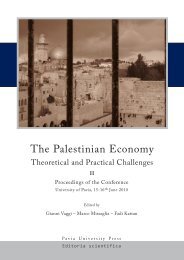Musica che affronta il silenzio - Scritti su Toru Takemitsu - Pavia ...
Musica che affronta il silenzio - Scritti su Toru Takemitsu - Pavia ...
Musica che affronta il silenzio - Scritti su Toru Takemitsu - Pavia ...
You also want an ePaper? Increase the reach of your titles
YUMPU automatically turns print PDFs into web optimized ePapers that Google loves.
Music Facing Up to S<strong>il</strong>ence. Writings on Tru Takemit<strong>su</strong><br />
Carter calls ‘the dialectic method of Western art music’ (Carter 1961: 127) 7 –<br />
undoubtedly represented a phase of great interest for Eastern composers looking West.<br />
The study of the twelve tone method and, later, of the serial approach was fundamental in<br />
the formation of many Japanese composers, including Yoshiro Irino, Makoto Moroi,<br />
Minao Shibata and Toshiro Mayuzumi, who in 1957 founded an Institute for New Music<br />
modelled on the one in Darmstadt. During the 1958 Ferienkurse Heinz-Klaus Metzger<br />
read a lecture by Yorit<strong>su</strong>ne Mat<strong>su</strong>daira (in German translation) in which it was stated that<br />
Japan’s interest for Western art music had existed for at least a century (Mat<strong>su</strong>daira<br />
1997). 8 However, in a lecture delivered to the Ferienkurse in 1962, the music critic H.<br />
Yoshida pointed out how the relationship between Japanese and European music had<br />
been decidedly one-way: apart from a few isolated cases, there was little question of<br />
Japanese composers exerting any influence on the European musical tradition. 9 To a<br />
lesser extent this disparity also held good in the contexts of painting and architecture, in<br />
which the encounter of the Western artist with Japan proved to be of prime importance in<br />
various phases of the 20 th century: indeed one might go so far as to say that the formation<br />
of modern art was patently linked to the confrontation with the Other of Western culture.<br />
Yoshida believed that over the last decade the situation had changed, also in the realm of<br />
music, and the participation of various Japanese composers in <strong>su</strong>ccessive Ferienkurse<br />
was a clear indication of this change. In addition his lecture tou<strong>che</strong>d on a topic that had<br />
<strong>su</strong>rfaced sporadically in Tokyo: it had become possible for the Japanese to have a less<br />
<strong>su</strong>perficial contact with the Western musical aesthetic precisely when Europeans stopped<br />
viewing other cultures as rudimental and underdeveloped with respect to their own. We<br />
can add that this became possible – rather later in music than in the other arts – thanks to<br />
an alliance between ethnography and avant-garde which manifested itself at various times<br />
and in different places during the 20 th century. 10<br />
In a lecture to the “Man<strong>il</strong>a International Music Symposium” in 1966, Chou Wenchung<br />
argued that ‘we have now rea<strong>che</strong>d a stage in which the beginning of a re-merger of<br />
Eastern and Western musical concepts and practices is actually taking place’ (Wen-chung<br />
1968-1969: 19). 11 The Chinese composer, who had emigrated to the United States in<br />
1946 and studied, among others, with Edgard Varèse, believed that this ‘re-merger’ had<br />
become possible from the moment when Western composers had stopped concentrating<br />
7 Also in Carter (2008: 164).<br />
8 On this topic cf. Galliano (2002).<br />
9 Cf. Hidekazu Yoshida, Kontakte zwis<strong>che</strong>n japanis<strong>che</strong>r und abendländli<strong>che</strong>r Musik, recording conserved<br />
in the Internationales Musikinstitut Darmstadt (I wish to thank Jürgen Krebber for kindly allowing me<br />
access to this source).<br />
10 Cf. Borio (2009).<br />
11 The proceedings of the symposium, The Musics of Asia, were edited by José Maceda of the National Music<br />
Counc<strong>il</strong> of the Ph<strong>il</strong>ippines in collaboration with UNESCO National Commission of the Ph<strong>il</strong>ippines in 1971.<br />
Here too one can note the presence of Xenakis, who read an early version of his fundamental essay ‘Vers une<br />
métamusique’ (1967) under the title ‘Structures Hors-temps’ (1971).<br />
111

















